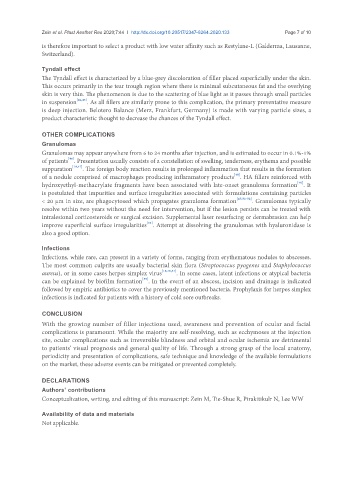Page 498 - Read Online
P. 498
Zein et al. Plast Aesthet Res 2020;7:44 I http://dx.doi.org/10.20517/2347-9264.2020.133 Page 7 of 10
is therefore important to select a product with low water affinity such as Restylane-L (Galderma, Lausanne,
Switzerland).
Tyndall effect
The Tyndall effect is characterized by a blue-grey discoloration of filler placed superficially under the skin.
This occurs primarily in the tear trough region where there is minimal subcutaneous fat and the overlying
skin is very thin. The phenomenon is due to the scattering of blue light as it passes through small particles
in suspension [44,45] . As all fillers are similarly prone to this complication, the primary preventative measure
is deep injection. Belotero Balance (Merz, Frankfurt, Germany) is made with varying particle sizes, a
product characteristic thought to decrease the chances of the Tyndall effect.
OTHER COMPLICATIONS
Granulomas
Granulomas may appear anywhere from 6 to 24 months after injection, and is estimated to occur in 0.1%-1%
[46]
of patients . Presentation usually consists of a constellation of swelling, tenderness, erythema and possible
suppuration [19,47] . The foreign body reaction results in prolonged inflammation that results in the formation
[48]
of a nodule comprised of macrophages producing inflammatory products . HA fillers reinforced with
[49]
hydroxyethyl‐methacrylate fragments have been associated with late-onset granuloma formation . It
is postulated that impurities and surface irregularities associated with formulations containing particles
< 20 µm in size, are phagocytosed which propagates granuloma formation [47,50-52] . Granulomas typically
resolve within two years without the need for intervention, but if the lesion persists can be treated with
intralesional corticosteroids or surgical excision. Supplemental laser resurfacing or dermabrasion can help
[53]
improve superficial surface irregularities . Attempt at dissolving the granulomas with hyaluronidase is
also a good option.
Infections
Infections, while rare, can present in a variety of forms, ranging from erythematous nodules to abscesses.
The most common culprits are usually bacterial skin flora (Streptococcus pyogenes and Staphylococcus
aureus), or in some cases herpes simplex virus [18,48,54] . In some cases, latent infections or atypical bacteria
[55]
can be explained by biofilm formation . In the event of an abscess, incision and drainage is indicated
followed by empiric antibiotics to cover the previously mentioned bacteria. Prophylaxis for herpes simplex
infections is indicated for patients with a history of cold sore outbreaks.
CONCLUSION
With the growing number of filler injections used, awareness and prevention of ocular and facial
complications is paramount. While the majority are self-resolving, such as ecchymoses at the injection
site, ocular complications such as irreversible blindness and orbital and ocular ischemia are detrimental
to patients’ visual prognosis and general quality of life. Through a strong grasp of the local anatomy,
periodicity and presentation of complications, safe technique and knowledge of the available formulations
on the market, these adverse events can be mitigated or prevented completely.
DECLARATIONS
Authors’ contributions
Conceptualization, writing, and editing of this manuscript: Zein M, Tie-Shue R, Pirakitikulr N, Lee WW
Availability of data and materials
Not applicable.

